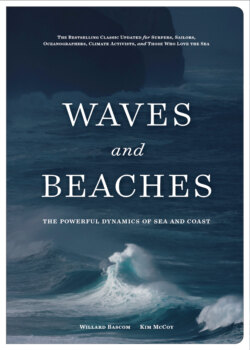Читать книгу Waves and Beaches - Kim McCoy - Страница 11
На сайте Литреса книга снята с продажи.
Preface to the Third Edition
ОглавлениеGenerations of scientists, surfers, and sailors have used Willard Bascom’s classic Waves and Beaches. This third edition celebrates the relationship of the sea and the land in the twenty-first century. And although time has passed since the first publication, the crashing of waves and the formation of beaches have not changed. The Sun’s heat still creates the winds, which transform into waves until dying in turbulence upon a shore. However, our measurement techniques, instrumentation, and interactions with the waves have all changed. The numbers of surfers, divers, kayakers, sailors, and people living in the coastal areas have increased immensely. The size of ships and the number of offshore structures have grown into a web of international commerce, that influences all humans. These changes now affect our urban planning, large-scale funding, and political decision-making—all upon an undeniably rising sea level and changing climate. But still, by understanding the origins of coastal dynamics, societies can anticipate coastal changes and respond to those changes in support of the well-being of their members. This edition of Waves and Beaches will help you take action and is in part why I became involved with its writing.
Satellites have deepened our understanding of the rapid changes affecting our coastlines. We now observe our planet’s dynamic distribution of water, ice, and water vapor through distant eyes. Water has acted as a thermostat to keep our planet habitable, but our thermostat—comfortably stable for most of the past 4,000 years—has been reset. We know our climate history from the story told by a million years of atmospheric gases trapped in glacial ice in Greenland and Antarctica, the amounts of which reveal periods of warm and cold. Coral reefs, oceanic sediments, tree rings, and plant pollen data recount our ocean temperatures over the same chapter of history. These are irrefutable records of our planet’s ancient sea levels, ocean currents, and atmospheric weather patterns.
These ancient dynamics have been disrupted by rapid population growth, the use of fossil fuels, the damming of rivers, the changing sediment loads, and the diversion of water flowing through estuaries and deltas as we contaminate aquifers with chemical pollutants. There is no alibi. The world’s oceans are experiencing more intense hurricanes, rising sea levels, coastal erosion, storm surges, and saltwater intrusion into our freshwater aquifers. The waves and beaches of the world are elevating their battle during this swiftly transforming era, the most turbulent time since the “rise of humanity.”
My awareness of the sea was early and multifaceted. By age five I had crossed the Pacific and Atlantic several times. I was bodysurfing by age nine, freediving at eleven, sailing at thirteen. Many of my teenage years were spent diving and exploring the same Pacific coast as Willard Bascom did in the 1940s. I have measured waves at sea from above, below, and within. I have spent many decades of my life aboard seagoing vessels, ashore examining beaches, all the while diving, surfing, and traveling the world’s shores.
At universities in Europe (on the Baltic and Mediterranean Seas) I studied math and physics, then oceanography in graduate school where I encountered the first edition of Waves and Beaches as a textbook. My professional involvement with waves began with funding from the Nearshore Sediment Transport Study (NSTS), which began where Bascom left off in the late 1970s. I became part of the “next wave” of coastal research in the 1980s. In the ensuing decades I plunged into the measurement of ocean turbulence, polar region science, oozing mud of the Amazon, instrument development, and global-scale changes.
In the latter 1990s Willard Bascom and I became friends. We spoke of diverse topics, sharing many interests including ancient history—bronzes from the age of Pericles—and waves. Indeed, as a father would interact with a son, he would give me “homework” to complete—he had not slowed down with age. Bascom would say, “Read this and tell me what you think.” Or he would ask me, “How do they measure this now?” One day he handed me the second edition of Waves and Beaches and commanded: “Read this and tell me what it needs.” That was the spark that marked the beginning of my transition from Bascom’s student to being his collaborator. This edition, Bascom’s last homework assignment for me, keeps the spirit of adventure alive while providing knowledge pertinent to the changes affecting us in the twenty-first century. It is my hope that this third edition of Waves and Beaches will help you take action and create your spark in the sea.
